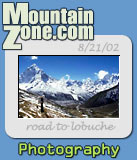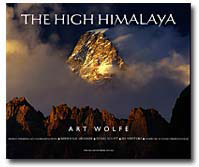
The High Himalaya
An Interview with Art Wolfe on the Publication of His New Book
October 17, 2001- Seattle, Washington
|
||
"I look at The High Himalaya as a project that would bring some humanity to a subject that is inherently overpowering in scale and grandeur," Wolfe told MountainZone.com in a recent interview. "I wanted to find a way to depict both the powerful impact of the great peaks as well as provide a meaningful look at the people who love among the mountains. I was seeking, too, the more subtle and more intimate landscapes of the Himalaya: the forests, the flowers, the smaller elements of that fascinating part of the world."
|
||
"At the time, Tibet was virtually a forbidden realm, and I wanted very much to see that place, that landscape, and the people who lived there," he said. "Going along as expedition photographer made that possible, and the impact of that journey still resonates."
For Wolfe, the expedition exposed him to a mountain landscape that would become a favorite, and gave him the time to experience the landscape in an intimate way. But it was the people who left the deepest impression on the photographer.
| " I always knew that to do the subject justice, I would have to spend decades, not months..." |
|||||
"I think one of the things I've noticed throughout the world is that once you get into the high mountains, the people who live there tend to be more open, more friendly, and more welcoming. I think that has to do with the hard work required for survival in those remote areas, the people seem to reflect a deeper humanity and empathy and say, a political consciousness."
The amount of time spent on this project adds up to one of the most exhaustive efforts ever made by the Seattle-based photographer.
"When people pick up one of my books," Wolfe said, "I think they say, 'wow, this guy's been busy the past couple of years.' And for some projects—such as The Living Wild, which was shot almost in its entirety in just two or three years, that may be true. But for the Himalayas, I always knew that to do the subject justice, I would have to spend decades, not months. Working on the book all these years was a great project for me, it forced me into regions that out of sheer laziness I might not have gone."
The High Himalaya stands out from other Wolfe books because it is more widely focused. Its subjects include landscapes, people, wildlife and even the minutia of life in the Himalaya.
"I can't imagine any book I've worked on in the past that allows the same opportunity to showcase the variety of subjects I shoot," Wolfe said. "Of course the mountains are the skeleton on which this book is built. The sheer grandeur, the beauty, the abstract nature of rock and ice on that scale means that it would be an omission if that weren't the focus. But I think the portraits of the people, the lichen on trees, the wildlife, add another dimension to the way people perceive this area. These are all subjects I wanted to bring to my audience, to show that while the mountains stand out, there is much, much more to the region."
But for Wolfe, who has been described as "the most prolific and sensitive recorder of the rapidly vanishing natural world," the sense of purpose he brings to a work like The High Himalaya sets him apart from other photographers.
"The excitement of doing a book like this," he said, "is not just to capture these images, but to bring them back the people who don't have the capabilities, the drive, or the time to go there themselves, to show people everywhere why this world is so interesting, or so beautiful. That's one of the things that drives me: to reveal, to highlight, to showcase what makes some places on earth special."


